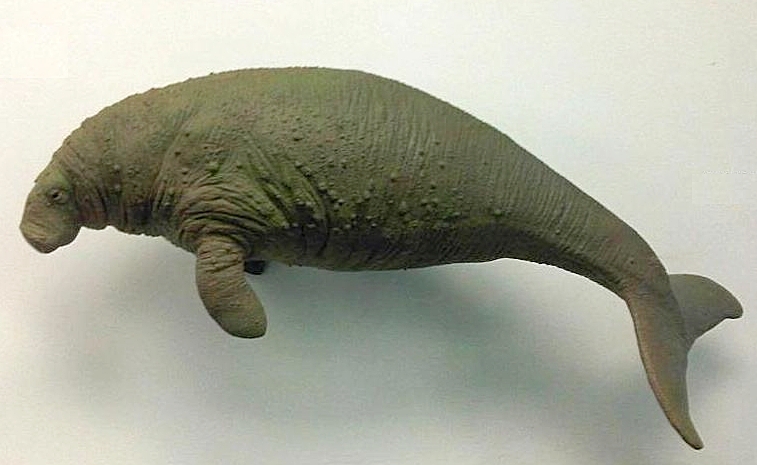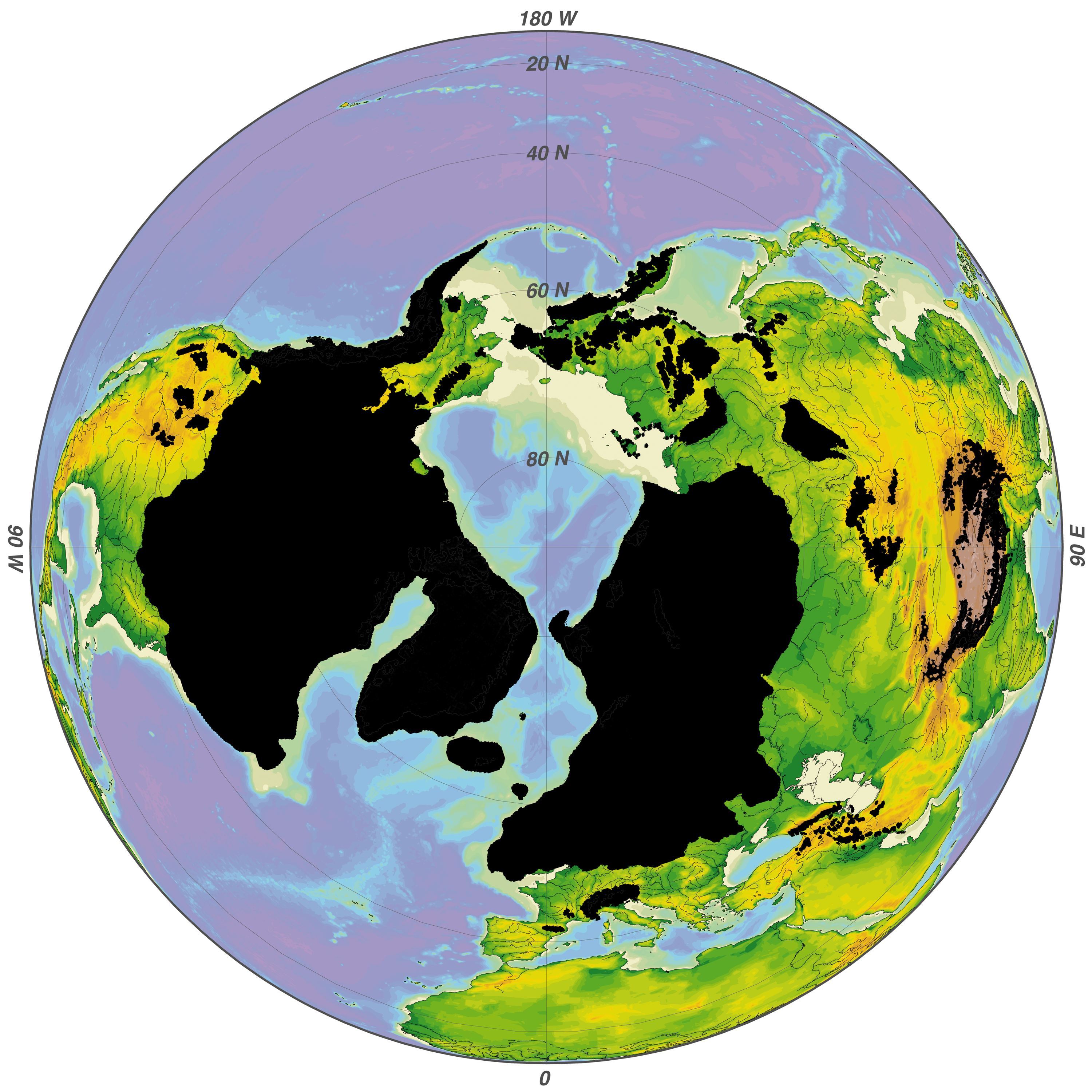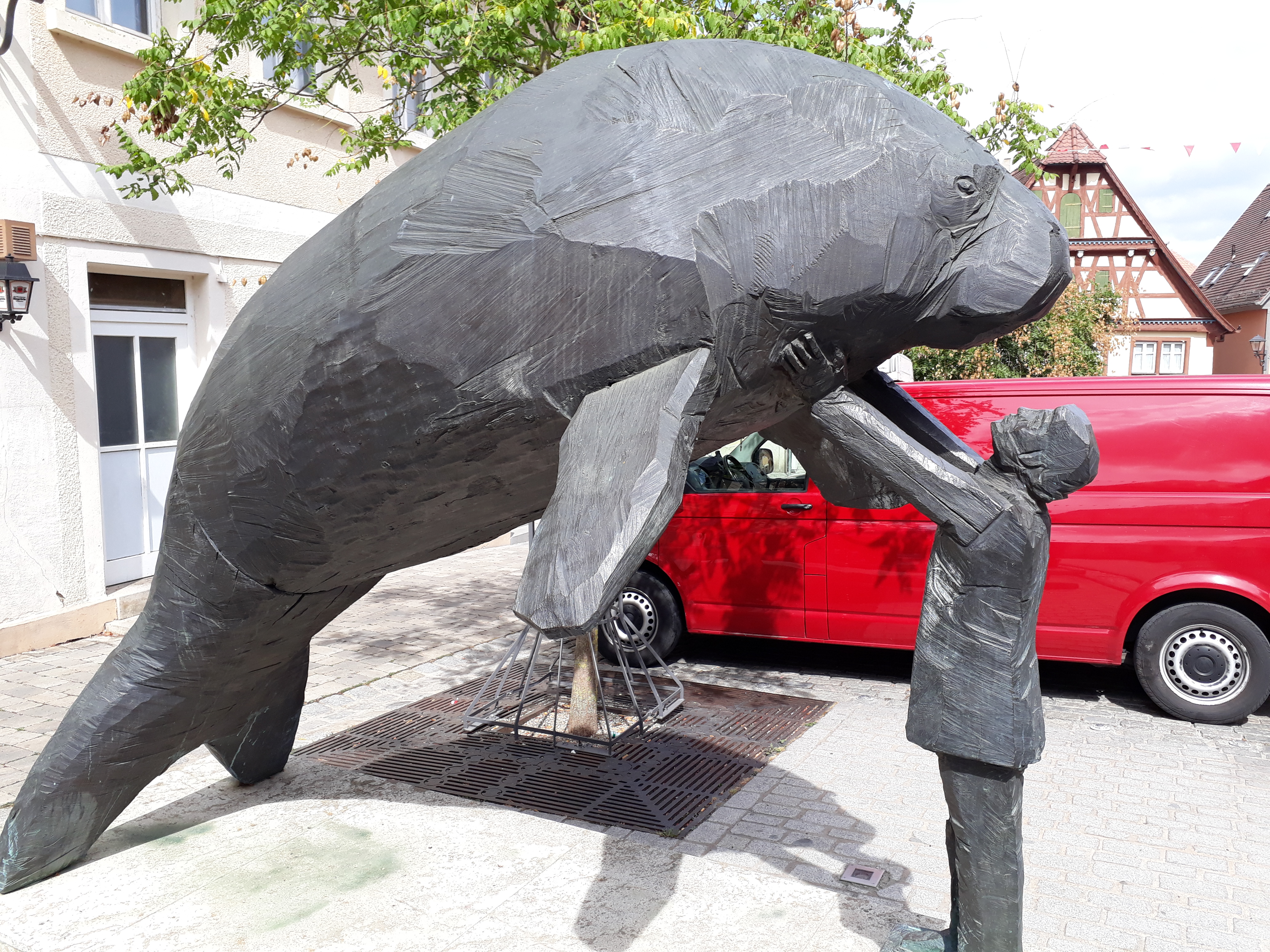|
Steller's Sea Cow
Steller's sea cow (''Hydrodamalis gigas'') is an extinction, extinct sirenian described by Georg Wilhelm Steller in 1741. At that time, it was found only around the Commander Islands in the Bering Sea between Alaska and Russia; its range extended across the North Pacific during the Pleistocene epoch (geology), epoch, and likely contracted to such an extreme degree due to the Quaternary glaciation, glacial cycle. It is possible that indigenous populations interacted with the animal before Europeans. Steller first encountered it on Vitus Bering's Great Northern Expedition when the crew became shipwrecked on Bering Island. Much of what is known about its behavior comes from Steller's observations on the island, documented in his posthumous publication ''On the Beasts of the Sea''. Within 27 years of its discovery by Europeans, the slow-moving and easily-caught mammal was hunted into extinction for its meat, fat, and hide. Some 18th-century adults would have reached weights of an ... [...More Info...] [...Related Items...] OR: [Wikipedia] [Google] [Baidu] |
Pleistocene
The Pleistocene ( ; referred to colloquially as the ''ice age, Ice Age'') is the geological epoch (geology), epoch that lasted from to 11,700 years ago, spanning the Earth's most recent period of repeated glaciations. Before a change was finally confirmed in 2009 by the International Union of Geological Sciences, the cutoff of the Pleistocene and the preceding Pliocene was regarded as being 1.806 million years Before Present (BP). Publications from earlier years may use either definition of the period. The end of the Pleistocene corresponds with the end of the last glacial period and also with the end of the Paleolithic age used in archaeology. The name is a combination of Ancient Greek () 'most' and (; Latinized as ) 'new'. The aridification and cooling trends of the preceding Neogene were continued in the Pleistocene. The climate was strongly variable depending on the glacial cycle, oscillating between cold Glacial period, glacial periods and warmer Interglacial, int ... [...More Info...] [...Related Items...] OR: [Wikipedia] [Google] [Baidu] |
Gustaf Johan Billberg
Gustaf Johan Billberg (14 June 1772, Karlskrona – 26 November 1844, Stockholm) was a Sweden, Swedish botanist, zoologist and anatomist, although professionally and by training he was a lawyer and used science and biology as an avocation. The plant genus ''Billbergia'' was named for him by Carl Peter Thunberg. Biography In 1790 he earned his legal degree at the University of Lund, later working as an auditor at the audit chamber in Stockholm from 1793. In 1798 he became a member of the county administrative board (''landskamrerare'') in Visby. In 1808 he returned to Stockholm, where from 1812 to 1837, he served as a member of the administrative court (''kammarrättsråd''). He was promoted in 1824 to head the ministry of the Board of Customs (''generaltullstyrelsen''). In 1812, he purchased the right of publishing to the precious work of ''Svensk Botanik'' from the estate of Johan Wilhelm Palmstruch. He subsequently prepared two parts for publication during 1812–1819. He was e ... [...More Info...] [...Related Items...] OR: [Wikipedia] [Google] [Baidu] |
Dugong
The dugong (; ''Dugong dugon'') is a marine mammal. It is one of four living species of the order Sirenia, which also includes three species of manatees. It is the only living representative of the once-diverse family Dugongidae; its closest modern relative, Steller's sea cow (''Hydrodamalis gigas''), was hunted to extinction in the 18th century. The dugong is the only sirenian in its range, which spans the waters of some 40 countries and territories throughout the Indo-West Pacific. The dugong is largely dependent on seagrass communities for subsistence and is thus restricted to the coastal habitats that support seagrass meadows, with the largest dugong concentrations typically occurring in wide, shallow, protected areas such as bays, mangrove channels, the waters of large inshore islands, and inter-reefal waters. The northern waters of Australia between Shark Bay and Moreton Bay are believed to be the dugong's contemporary stronghold. Like all modern sirenians, the d ... [...More Info...] [...Related Items...] OR: [Wikipedia] [Google] [Baidu] |
Dugongidae
Dugongidae is a Family (biology), family in the Order (biology), order of Sirenia. The family has one surviving species, the dugong (''Dugong dugon''), one recently Extinction, extinct species, Steller's sea cow (''Hydrodamalis gigas''), and a number of extinct Genus, genera known from fossil records. Dugongidae's body weight ranges from 217 to 307 kg for juveniles, 334 to 424 kg for subadults, and 435 to 568.5 kg for adults. Oral temperatures for individual dugongs is determined from 24° to 34.2 °C. Heart rate readings are from 40 to 96 bpm and vary between individual dugongs. Respiration rate during the out-of-water phase is from 1 to 33. Taxonomy * Family Dugongidae ** Genus extinction, †''Anisosiren'' ** Genus †''Caribosiren'' ** Genus †''Indosiren'' ** Genus †''Lentiarenium'' ** Genus †''Kaupitherium'' ** Genus †''Paralitherium'' ** Genus †''Priscosiren'' ** Genus †''Prohalicore'' ** Genus †''Sirenavus'' ** Subfamily †Halitheriinae ... [...More Info...] [...Related Items...] OR: [Wikipedia] [Google] [Baidu] |
Great Northern Expedition
The Great Northern Expedition () or Second Kamchatka Expedition () was a major Russian Arctic expedition between roughly 1733 and 1743, which mapped most of the Arctic coast of Siberia and much of the Arctic coast of North America, greatly reducing "white areas" on maps. It was conceived by Russian emperor Peter the Great, and took place under empresses Anna and Elizabeth. Peter hoped for the 18th-century Russian Navy to map a Northern Sea Route from Europe to the Pacific. The endeavour was sponsored by the Admiralty College in Saint Petersburg. The main organiser and leader of the expedition was Vitus Bering, who had been commissioned by Peter to lead the earlier First Kamchatka Expedition (1725 to 1731). With over 3,000 people directly or indirectly involved, it was one of the largest expeditions in history. The expedition's primary objective was reaching the eastern reaches of Siberia, and from there the western shores of North America. The expedition included the Europea ... [...More Info...] [...Related Items...] OR: [Wikipedia] [Google] [Baidu] |
Vitus Bering
Vitus Jonassen Bering ( , , ; baptised 5 August 1681 – 19 December 1741),All dates are here given in the Julian calendar, which was in use throughout Russia at the time. also known as Ivan Ivanovich Bering (), was a Danish-born Russian cartographer and explorer, and an officer in the Russian Navy. He is known as a leader of two Russian expeditions, namely the First Kamchatka Expedition and the Great Northern Expedition, exploring the north-eastern coast of the Asian continent and from there the western coast on the North American continent. The Bering Strait, the Bering Sea, Bering Island, the Bering Glacier, and Vitus Lake were all named in his honor. Taking to the seas as a ship's boy at the age of 15, Bering travelled extensively over the next eight years, as well as taking naval training in Amsterdam. In 1704, he enrolled with the rapidly expanding navy of Tsar Peter I. After serving with the navy in significant but non-combat roles during the Great No ... [...More Info...] [...Related Items...] OR: [Wikipedia] [Google] [Baidu] |
Quaternary Glaciation
The Quaternary glaciation, also known as the Pleistocene glaciation, is an alternating series of glacial period, glacial and interglacial, interglacial periods during the Quaternary period that began 2.58 Year#SI prefix multipliers, Ma (million years ago) and is ongoing. Although geologists describe this entire period up to the present as an "ice age", in popular culture this term usually refers to the Last Glacial Period, most recent glacial period, or to the Pleistocene epoch in general. Since Earth still has polar Ice sheet, ice sheets, geologists consider the Quaternary glaciation to be ongoing, though currently in an interglacial period. During the Quaternary glaciation, ice sheets appeared, expanding during glacial periods and contracting during interglacial periods. Since the end of the last glacial period, only the Antarctic ice sheet, Antarctic and Greenland ice sheets have survived, while other sheets formed during glacial periods, such as the Laurentide Ice Sheet, hav ... [...More Info...] [...Related Items...] OR: [Wikipedia] [Google] [Baidu] |
Epoch (geology)
The geologic time scale or geological time scale (GTS) is a representation of time based on the rock record of Earth. It is a system of chronological dating that uses chronostratigraphy (the process of relating strata to time) and geochronology (a scientific branch of geology that aims to determine the age of rocks). It is used primarily by Earth scientists (including geologists, paleontologists, geophysicists, geochemists, and paleoclimatologists) to describe the timing and relationships of events in geologic history. The time scale has been developed through the study of rock layers and the observation of their relationships and identifying features such as lithologies, paleomagnetic properties, and fossils. The definition of standardised international units of geological time is the responsibility of the International Commission on Stratigraphy (ICS), a constituent body of the International Union of Geological Sciences (IUGS), whose primary objective is to precis ... [...More Info...] [...Related Items...] OR: [Wikipedia] [Google] [Baidu] |
Russia
Russia, or the Russian Federation, is a country spanning Eastern Europe and North Asia. It is the list of countries and dependencies by area, largest country in the world, and extends across Time in Russia, eleven time zones, sharing Borders of Russia, land borders with fourteen countries. Russia is the List of European countries by population, most populous country in Europe and the List of countries and dependencies by population, ninth-most populous country in the world. It is a Urbanization by sovereign state, highly urbanised country, with sixteen of its urban areas having more than 1 million inhabitants. Moscow, the List of metropolitan areas in Europe, most populous metropolitan area in Europe, is the capital and List of cities and towns in Russia by population, largest city of Russia, while Saint Petersburg is its second-largest city and Society and culture in Saint Petersburg, cultural centre. Human settlement on the territory of modern Russia dates back to the ... [...More Info...] [...Related Items...] OR: [Wikipedia] [Google] [Baidu] |
Alaska
Alaska ( ) is a non-contiguous U.S. state on the northwest extremity of North America. Part of the Western United States region, it is one of the two non-contiguous U.S. states, alongside Hawaii. Alaska is also considered to be the northernmost, westernmost, and easternmost (the Aleutian Islands cross the 180th meridian into the eastern hemisphere) state in the United States. It borders the Canadian territory of Yukon and the province of British Columbia to the east. It shares a western maritime border, in the Bering Strait, with Russia's Chukotka Autonomous Okrug. The Chukchi and Beaufort Seas of the Arctic Ocean lie to the north, and the Pacific Ocean lies to the south. Technically, it is a semi-exclave of the U.S., and is the largest exclave in the world. Alaska is the largest U.S. state by area, comprising more total area than the following three largest states of Texas, California, and Montana combined, and is the seventh-largest subnational division i ... [...More Info...] [...Related Items...] OR: [Wikipedia] [Google] [Baidu] |
Bering Sea
The Bering Sea ( , ; rus, Бе́рингово мо́ре, r=Béringovo móre, p=ˈbʲerʲɪnɡəvə ˈmorʲe) is a marginal sea of the Northern Pacific Ocean. It forms, along with the Bering Strait, the divide between the two largest landmasses on Earth: Eurasia and the Americas. It comprises a deep water basin, which then rises through a narrow slope into the shallower water above the continental shelf, continental shelves. The Bering Sea is named after Vitus Bering, a Denmark, Danish-born Russia, Russian navigator, who, in 1728, was the first European to systematically explore it, sailing from the Pacific Ocean northward to the Arctic Ocean. The Bering Sea is separated from the Gulf of Alaska by the Alaska Peninsula. It covers over and is bordered on the east and northeast by Alaska, on the west by the Russian Far East and the Kamchatka Peninsula, on the south by the Alaska Peninsula and the Aleutian Islands and on the far north by the Bering Strait, which connects the Berin ... [...More Info...] [...Related Items...] OR: [Wikipedia] [Google] [Baidu] |
Georg Wilhelm Steller
Georg Wilhelm Steller (10 March 1709 – 14 November 1746) was a German-born naturalist and explorer who contributed to the fields of biology, zoology, and ethnography. He participated in the Great Northern Expedition (1733–1743) and his observations of the natural world helped the exploration and documentation of the flora and fauna of the North Pacific region. Steller pursued studies in theology and medicine before turning his attention to the natural sciences. In 1734, he joined the Russian Academy of Sciences as a physician, eventually being selected to accompany Bering's expedition to the uncharted waters between Siberia and North America. Steller kept detailed records of species and cultures encountered, as well as ocean currents during the journey. Steller discovered many new species, as he documented numerous plants and animals, many of which were previously unknown to Western science. Notable among his discoveries was the Steller's sea cow and Steller's sea eagle. ... [...More Info...] [...Related Items...] OR: [Wikipedia] [Google] [Baidu] |










